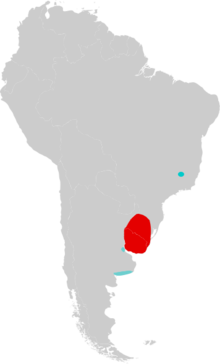
Back جرذ لوند Arabic جرذ لوند ARZ Slakevol (Lundomys molitor) AVK Lundomys molitor Catalan Lundomys molitor CEB Lund-Wasserratte German Lundomys molitor Spanish Lundomys molitor Basque Lundomys molitor French Lundomys molitor Italian
| Lundomys Temporal range: Late Pleistocene to Recent (Lujanian)
| |
|---|---|

| |
| Lectotype partial cranium of L. molitor. The illustrated mandible represents a different species. | |
| Scientific classification | |
| Domain: | Eukaryota |
| Kingdom: | Animalia |
| Phylum: | Chordata |
| Class: | Mammalia |
| Order: | Rodentia |
| Family: | Cricetidae |
| Subfamily: | Sigmodontinae |
| Genus: | Lundomys Voss & Carleton, 1993 |
| Species: | L. molitor
|
| Binomial name | |
| Lundomys molitor (Winge, 1887)
| |

| |
| Distribution of Lundomys molitor in South America. The current distribution is in red, and fossil records outside the current range are in blue. | |
| Synonyms[2] | |
| |
Lundomys molitor, also known as Lund's amphibious rat[3] or the greater marsh rat,[4] is a semiaquatic rat species from southeastern South America.
Its distribution is now restricted to Uruguay and nearby Rio Grande do Sul, Brazil, but it previously ranged northward into Minas Gerais, Brazil, and southward into eastern Argentina. The Argentine form may have been distinct from the living form from Brazil and Uruguay. L. molitor is a large rodent, with the head and body length averaging 193 mm (7.6 in), characterized by a long tail, large hindfeet, and long and dense fur. It builds nests above the water, supported by reeds, and it is not currently threatened.
Its external morphology is similar to that of Holochilus brasiliensis, and over the course of its complex taxonomic history it has been confused with that species, but other features support its placement in a distinct genus, Lundomys. Within the family Cricetidae and subfamily Sigmodontinae, it is a member of a group of specialized oryzomyine rodents that also includes Holochilus, Noronhomys, Carletonomys, and Pseudoryzomys.
© MMXXIII Rich X Search. We shall prevail. All rights reserved. Rich X Search
